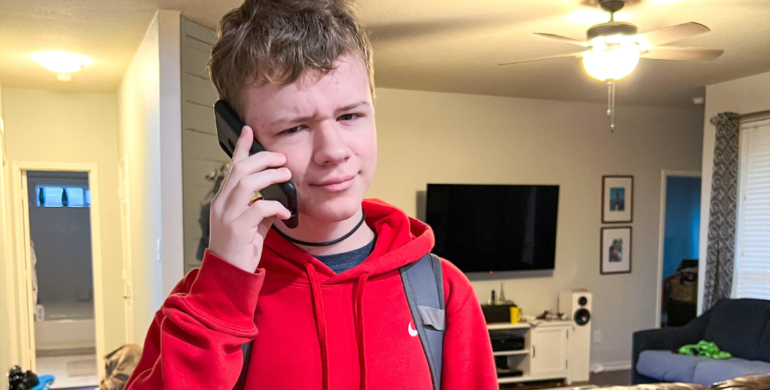This post contains affiliate links which means items purchased through these links return a small monetary percentage back to this blog. Read our full disclosure policy here.
It goes without saying that the world today’s teens live in is drastically different than the world we grew up in. One of the major differences is the availability of instant and constant communication and activities online. As parents, we are entering uncharted territory in many ways. While I’m far from an expert, I have learned a few things that have helped us navigate the unique challenges. Here are a few things I would encourage parents to consider to keep teens safe online.
1. Talk to Your Kids Often
It’s important to start the conversation about online safety when kids are young and explain why we have certain limits in an age-appropriate manner. Let your kids know they can come to you any time they come across something strange, inappropriate, or makes them feel uncomfortable in any kind of way.
2. Remind Teens That the Internet is Forever
No matter how private your teen thinks their messages and photos are, messages and photos stick around forever and can come back up later in life. You can also say things in the heat of the moment that are hard to take back. Keep private thoughts and photos private. If you don’t want the entire world to see something, it’s better kept offline.
3. Update the Privacy Settings
Ensure any profiles and accounts your children use are locked down so the whole world can’t see their information and photos. Let your kids know that they should not share their address or phone number with strangers.
4. Be Cautious About Spam and Scams
There are so many fake accounts these days and they are getting smarter and smarter about finding ways to look real and gain access to you and/or your children. If you don’t know the person, don’t accept friend requests. Kids don’t always understand that people may not be telling the truth about who they are. This is such an important part of how to keep teens safe online.
Be sure to coach them about emails that may be promising things that are too good to be true, and avoid clicking any links that they don’t know for sure are safe. Also, let them know they need to be careful downloading programs or files they aren’t sure are legitimate. This is one way malware finds its way to your devices. If they make online purchases, emphasize that they should only purchase items from reputable vendors.
5. Update and Adjust Parental Controls
Setting up parental controls is helpful, but not foolproof. There are always ways that, eventually, kids and teens can find a way around. One of the most helpful settings on our iPads is time limits. I found that the longer my children used certain apps, like YouTube (even YouTube Kids), the more likely they were to find their way to questionable content…usually completely unintentionally. Clicking on suggested videos prompts the algorithm to show them more related content, and the creators of inappropriate content are very savvy about finding ways around the safety standards you have set up. Limiting time spent on individual apps helps reduce the clicking and wandering into unknown spaces.
Make sure there is password protection on devices so if they are left somewhere, others won’t be able to access their personal information.
Safe Phones For Teens and Online Monitoring
We’ve chosen to get our teen a Gabb phone. I love this phone because it looks like a smart phone (has a touch screen and a few simple apps), and can call and text, but does not have access to the internet or social media. It has allowed us to stay in contact with our child as he goes to various activities without the worry of accessing distracting or inappropriate content online.
Are you interested in trying the Gabb phone? Use my promo code CRAZY for a special offer.
Monitoring Software To Keep Teens Safe Online
We also use Bark online monitoring software to monitor our kids’ devices. Bark can block many inappropriate websites and it also scans devices and apps to flag content that has been viewed which may be inappropriate. You can adjust the settings to determine how and what type of content you want the software to look for. Bark also makes a great first phone for kids.
Stay Aware of Trends
There is so much more to discuss that I can’t cover here, and probably many more things I don’t even know about yet. There’s always going to be a new app, a new way to communicate, and changes in our world to keep up with. Continue educating yourself along the way. This is just a starting point to give an overview of what’s out there and what you can do to educate your children about it.
For more information about how to keep teens safe online, check out onlinesense.org.
You Might Also Like:
- When Something Isn’t Right: Tongue Ties and Breastfeeding Problems
- Why Are Women So Tired?
- Easy Mother’s Day Gift Ideas
- Stop Using Mental Health Treatments as Insults
- Last Minute Easter Basket Ideas for Teens and Tweens




